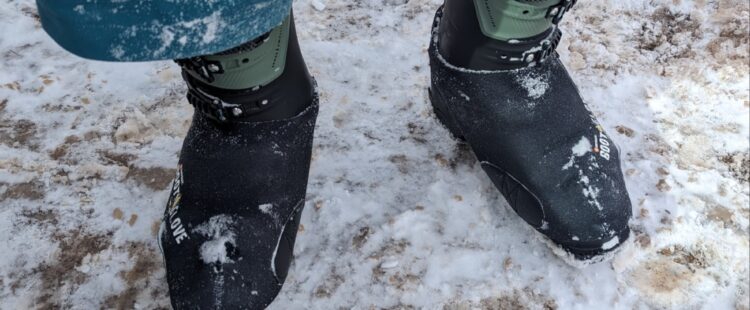Disclosure: I may earn affiliate revenue or commissions if you purchase products from links on my website. The prospect of compensation does not influence what I write about or how my posts are structured. The vast majority of articles on my website do not contain any affiliate links.
Many a ski day has been cut short by cold toes. A common frustration amongst all skiers is, surely, spending thousands of dollars on gear only to discover an acute source of discomfort and numbness whenever the temperature drops below a certain mark.
We seek warmth on the slopes by expending more energy, seeking lower elevations or sunnier terrain, and by altering our gear. Most often by bundling up—adding more layers of clothing, covering exposed skin, and switching out lighter clothing for that which is better insulated.
When it comes to warming the body’s core, the chilly skier almost total freedom. The options are endless, and if six layers upon the torso meets one’s needs for function and comfort, so be it. More heat overall can help alleviate issues with the body’s extremities. But if you’re researching foot-specific solutions, you’re probably sick of hearing that adage.
Significant constraints accompany attempts to warm feet and toes in ski boots. Ski boots are stiff and rigid and must tightly conform to the geometry of the calf, through the ankle, and through the foot. Boot fitting is big business, and owning the right boot for your ability level that fits correctly is crucial because boots are a key part of the magical physics equation of downhill skiing.
After finding a boot that fits, there’s not much room for customization. You’re only supposed to wear one pair of socks. Though plenty of custom footbeds exist, inserting one can dramatically change the inner volume of the boot. After-market liners are fairly expensive, not available for every shell, and, in my experience, usually make no difference in keeping the toes warm, since that layer of fabric tends to be of identical thickness.
Now, do I still double up my ski socks on occasion? Yes. Do socks with a higher warmth rating make a difference? Yes. Have I dabbled with prying footbeds out of running shoes to improve the fit and warmness of my ski boots? Yes. Did I pay quite a bit of money to buy the most premium liner for my old Full Tilt boots? I sure did. Boot fitters would tell you that boot fitting is an exact science, and I largely agree. A minor modification that you can reverse without ruining your ski day is not some sort of sacrilege. As frustration over cold toes mounts, the casual skier will be so moved to make more drastic changes, the kind that can ruin a ski weekend or can cost as much as a season pass.
These things considered, it is logical to wonder if there exists an item that could be affixed to the outside of the boot shell without affecting the form or functionality of the boot. This line of inquiry led me to the DryGuy BootGlove Ski Boot Covers, which I purchased earlier this season after a frustratingly cold day on the slopes.
Context for this Review
When I started evaluating the BootGloves this season, I was open minded because they were an inexpensive, built-for-purpose (potential) solution to a ubiquitous problem. In previous seasons, I regarded the BootGloves, seemingly only worn by old men and never worn by diehard skiers, as a whimsical accessory. After quite a bit of testing this season, I’m ready to deliver my verdict.
Testing ski gear is difficult. Conditions are never the same day over day, or even from morning to afternoon. Though I was able to swap some gear mid-ski-day in order to claim some semblance of scientific methodology, any tests were ultimately flawed, and I never used measuring devices.
To help establish the basis of my senses, and what informs my own feelings, I will note that I downhill ski a fair bit, at least 20 days per year. I also run in all weather conditions and nordic ski, so I’m pretty well calibrated when it comes to arbitrating the differences between discomfort and danger in the cold.
DryGuy BootGlove Ski Boot Covers
The DryGuy BootGlove Ski Boot Covers (henceforth referred to as the BootGloves) are a pair of inexpensive, lightweight, washable, 4.5mm thick, neoprene covers that can be affixed to any downhill skiing boots. They come in three sizes: small, medium, and large, and there’s some overlap between sizes due to the adjustable heel strap. I’ve noticed some ski shops only carrying the medium size, and that is what I ended up purchasing.
The medium-sized gloves weight 8.11oz each and are soft and spongey to the touch. To strap a cover onto a boot, you must tighten your buckles and remove your boot from ski bindings. You simply slip the toe of the boot into the cover, with the BootGlove strap under your forefoot, then fasten the velcro strap behind the heel of your boot. The BootGloves are somewhat ergonomic with edge-guards on each outer side, so there is a notion of right and left covers.
The claim behind this product is straightforward. The liner insulates the most exposed portion of the ski boot, protecting it from wind, coldness, and wetness. Without an external cover, toes inside a plastic boot shell can feel as if they are getting battered by the elements. The BootGloves should eliminate the need for double (or triple) socks, expensive integrated heating systems (or heated socks), or the practice of stuffing hand warmers into ski boots. They carry the promise of extending the ski day. If your feet ever become too hot, they can be removed and stored in a coat pocket. Specifically, the claim is that they can preserve “20 degrees” of warmth inside the boot.
Of course, these boot covers must do something–they must have some effect. Next, I will recount my personal experience and aggregate some other information I found while researching the product.
My Experience with BootGloves
BootGloves are incredibly easy to put on or take off. A more pressing concern is how they affect walking in boots. Walking in ski boots is a difficult task to begin with. The thin strap that loops under the forefoot of the boot overlaps a portion where a boot may have some traction. Additionally, the cover can obstruct the hitch on the front of ski boots which can usually be relied upon when digging the toes in while walking up steeper, snowy hills. While the product adds some awkwardness in extremely slick conditions, it’s not enough to comment on. There’s really not a downside here.
An actual downside, for those with certain habits, is that the gloves cover several buckles on ski boots. So, if you are apt to make minor boot adjustments during the day, or you are someone who unclasps buckles on the chairlift, those actions will be made much more difficult. You’ll pretty much have to completely remove the glove to adjust the buckles above the foot.
Some prospective buyers have wondered whether the strap under the foot can interfere with a binding’s anti-friction device. For the uninitiated, this “device” is a bumper that can slide left to right in order to dissipate forces. In my experience, the anti-friction functionality of bindings is not impacted whatsoever.
Another concern related to the bottom strap is with the durability of the product. Many users report that, if the gloves are left on while walking on rough concrete, the bottom strap can quickly degrade. Thankfully, this is wholly preventable by simply removing the glove when it comes time to walk on a hard surface.
It also should be stated that the BootGloves are ugly. There is a bit of a connotation attached to those who wear these, and that would be that you aren’t a particularly elite skier. Additionally, since they sit on top of your boots, they make your feet look even bulkier, which recalls some instinct of wanting to make fun of a person due to their choice of footwear.
So, do they actually work?
When it comes down to it, despite some absolutely glowing reviews, DryGuy does not make any outrageous, or really even any specific, claims regarding what this product is actually supposed to do. The only claim, for which I cannot find any scientific evidence supporting, is that the product “helps retain up to 20 degrees [of heat] inside the boot.” This seems logical.
I tried using the product in many different scenarios. I will say that, once my toes were cold, wrapping my previously-exposed boots in the BootGloves in the middle of the mountain did absolutely nothing. They don’t provide anything resembling an instant warming or gradual warming effect.
Where the BootGloves did work, was when I went inside to warm my toes up after not having worn them, and then putting them on. On a frigidly cold day, where my toes would be painfully numb after 3 runs, the BootGloves extended my warmth to 4 or 5 runs. However, there was not a magical barrier of warmth. After those few extra runs, my toes were back to being painfully numb. On warmer days, my toes did not become frigidly cold without the covers, so I was not able to estimate how much they extended my skiing time in those conditions.
I think that the best, most scientific, test is wearing a BootGlove on one boot while leaving the other one bare. In these tests, there was an apparent difference, though not night and day.
In conclusion, this product insulates ski boots to some degree, but is not a silver bullet solution for keeping your feet and toes warm. Considering ease of use and price, I found it to be a worthwhile investment for extending the ski day. Let me know what you think below.
How to Buy DryGuy BootGlove Ski Boot Covers
I’ve found that many ski shops, and even some general outdoor-oriented stores, carry this product. Unless you are unlucky, without any markup over MSRP. If you need the covers in a pinch while already on the mountain, it wouldn’t hurt to check. Otherwise, they can be purchased on Amazon here, where DryGuy has a dedicated store.



